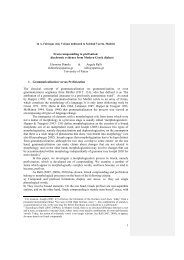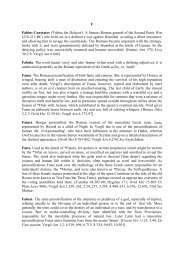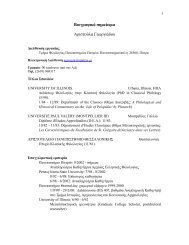Case mismatches in Greek: Evidence for the autonomy of morphology
Case mismatches in Greek: Evidence for the autonomy of morphology
Case mismatches in Greek: Evidence for the autonomy of morphology
Create successful ePaper yourself
Turn your PDF publications into a flip-book with our unique Google optimized e-Paper software.
182 manuel espaol-echevarra and angela ralli<br />
(4) ()I tites, i kathigites tus agapane olus 3<br />
<strong>the</strong> students-nom, <strong>the</strong> pr<strong>of</strong>essors-nom <strong>the</strong>m-acc love-3pl all-acc<br />
`The pr<strong>of</strong>essors love all <strong>the</strong> students' (or The students, <strong>the</strong> pr<strong>of</strong>essors love <strong>the</strong>m all)<br />
In (3a), <strong>the</strong> head <strong>of</strong> <strong>the</strong> dislocated free relative opjos occurs <strong>in</strong> nom<strong>in</strong>ative<br />
case, although it is co<strong>in</strong>dexed with an accusative clitic, i.e., ton. In (3b), <strong>the</strong><br />
head <strong>of</strong> <strong>the</strong> dislocated free relative opjon is <strong>in</strong> <strong>the</strong> same case (Accusative) as<br />
<strong>the</strong> co<strong>in</strong>dexed clitic <strong>in</strong> <strong>the</strong> matrix clause, but this Accusative case cannot be<br />
checked aga<strong>in</strong>st <strong>the</strong> verb <strong>of</strong> <strong>the</strong> relative which requires nom<strong>in</strong>ative case. In (4),<br />
<strong>the</strong> dislocated DP i tites `<strong>the</strong> students' shows nom<strong>in</strong>ative case, but it is co<strong>in</strong>dexed<br />
with an accusative clitic, i.e., tus `<strong>the</strong>m'. These <strong>Case</strong> <strong>mismatches</strong> pose<br />
a problem <strong>for</strong> Baker's (1996) unied account <strong>of</strong> dislocated constituents <strong>in</strong> both<br />
polysyn<strong>the</strong>tic and non-polysyn<strong>the</strong>tic languages. In addition, <strong>the</strong> examples <strong>in</strong><br />
(3) and (4) raise more general questions on <strong>Case</strong> <strong>the</strong>ory. In (3b), <strong>the</strong> Nom<strong>in</strong>ative<br />
syntactic or abstract <strong>Case</strong> associated with <strong>the</strong> verb grapsi `write-perf' does<br />
not show up on any lexical item <strong>of</strong> <strong>the</strong> sentence, whereas (3a) <strong>in</strong>dicates that<br />
it may show up, cf. opjos `whoever-nom'. On <strong>the</strong> o<strong>the</strong>r hand, <strong>the</strong> nom<strong>in</strong>ative<br />
<strong>Case</strong> <strong>of</strong> <strong>the</strong> CLLD DP i tites `<strong>the</strong> students-nom' does not seem to be related<br />
to any syntactic <strong>Case</strong> assigned by <strong>the</strong>verb agapane `love-3pl' <strong>in</strong> (4).<br />
The examples <strong>in</strong> (3)(4) call <strong>for</strong> a re<strong>for</strong>mulation <strong>of</strong> Baker's Cha<strong>in</strong> Condition<br />
<strong>in</strong> (1), particularly, <strong>in</strong> relation to <strong>the</strong> nondist<strong>in</strong>ctiveness <strong>in</strong> <strong>Case</strong> condition<br />
on <strong>the</strong> elements <strong>of</strong> a non-movement cha<strong>in</strong>. This re<strong>for</strong>mulation should be able<br />
to account also <strong>for</strong> <strong>the</strong> two follow<strong>in</strong>g facts. (a) The relative pronoun or <strong>the</strong><br />
DP must bear <strong>the</strong> <strong>Case</strong> marker checked by <strong>the</strong> matrix verb if <strong>the</strong>y appear <strong>in</strong><br />
a non-dislocated position. Compare (5a) to (3a) and (6a) to (4), respectively:<br />
3<br />
<strong>Case</strong> <strong>mismatches</strong> such as <strong>the</strong> one illustrated <strong>in</strong> (4) are always slightly deviant, as <strong>in</strong>dicated<br />
by <strong>the</strong> question mark, although grammatical. As noted by Tzartzanos (1946),<br />
this type <strong>of</strong> <strong>Case</strong> <strong>mismatches</strong> are much better if some material (related to <strong>the</strong> dislocated<br />
constituent) <strong>in</strong>tervenes between <strong>the</strong> dislocated constituent and <strong>the</strong> rest <strong>of</strong> <strong>the</strong><br />
sentence:<br />
(i) I kira-R<strong>in</strong>i tu Kritu, tu Duka i<br />
<strong>the</strong>-nom miss-Irene-nom <strong>the</strong>-gen Kritos-gen, <strong>the</strong>-gen Duka-gen <strong>the</strong>-nom<br />
thigatera, xronia tis etimazun ta prikia<br />
daughter-nom, years-acc her-gen prepare-3pl <strong>the</strong> dot<br />
`Mrs. Irene <strong>of</strong> Kritos, Duka's daughter, <strong>the</strong>y prepare her dot <strong>for</strong> years'<br />
(from Tzartzanos (1946, 264))<br />
In spite <strong>of</strong> <strong>the</strong> dierence <strong>in</strong> acceptability between (3) and (4), we will treat <strong>Case</strong> <strong>mismatches</strong><br />
<strong>in</strong>volv<strong>in</strong>g topicalized free relatives, cf. (3) <strong>in</strong> <strong>the</strong> text, and <strong>Case</strong> <strong>mismatches</strong><br />
<strong>in</strong>volv<strong>in</strong>g topicalized DPs, cf. (4), <strong>in</strong> a unied way. Both cases illustrate <strong>Case</strong> <strong>mismatches</strong><br />
<strong>in</strong> CLLD cha<strong>in</strong>s.<br />
Acta L<strong>in</strong>guistica Hungarica 47, 2000










